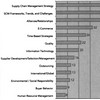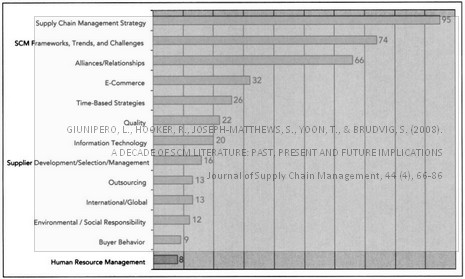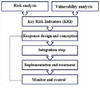 What has been achieved, or rather: written, during a decade of academic research in the Supply Chain Management (SCM) field? A lot, obviously, but despite the considerable number of academic contributions, the literature is still very fragmented and although several studies purport to discuss supply chain issues, most of the existing research only examines one link of the chain, or more importantly only focuses on one ingredient in the supply chain performance mix. So say Larry Giunipero, Robert E Hooker, Sacha Joseph-Matthews, Tom E Yoon and Susan Brudvig in their 2008 article on A Decade of SCM Literature: Past, Present and Future Implications, where they investigate and categorize some 405 articles from 9 academic journals. Their findings are quite interesting.
What has been achieved, or rather: written, during a decade of academic research in the Supply Chain Management (SCM) field? A lot, obviously, but despite the considerable number of academic contributions, the literature is still very fragmented and although several studies purport to discuss supply chain issues, most of the existing research only examines one link of the chain, or more importantly only focuses on one ingredient in the supply chain performance mix. So say Larry Giunipero, Robert E Hooker, Sacha Joseph-Matthews, Tom E Yoon and Susan Brudvig in their 2008 article on A Decade of SCM Literature: Past, Present and Future Implications, where they investigate and categorize some 405 articles from 9 academic journals. Their findings are quite interesting.
Quo vadis, SCM?
Two weeks ago I asked the question, Quo Vadis, SCRM?, and the direction of supply chain risk research seems to be very similar to supply chain management research, which is only naturally, since one provides the basis for the other. Today’s article investigates the history of the SCM literature looking at the various trends and developments in the field through a historical analysis covering the 10-year-period between 1997 and 2006. During this decade, SCM evolved into a more prominent area of research, or borrowed its way to a discipline as Smith and Buddress (2005) call it. Supply chain management always has been and probably always will be a melting pot of various disciplines, with influences from logistics and transportation, operations management and materials and distribution management, marketing as well as purchasing and information technology, and manyothers, all working together “to produce an overall supply chain strategy that ultimately enhances firm performance.”
The top three topics of SCM to date
Analyzing past and present literature the authors find 13 topics or categories of topics, three of which stand out more prominently than the 10 others:

- SCM Strategy 23%
- e.g. Strategic alignment, competitive advantage, agency theory, risk management
- SCM Frameworks, Trends and Challenges 18%
- e.g.Trends, definitions, reviews and problems
- Alliances/Relationships 16%
- e.g. Relationship building, trust, commitment, vertical and horizontal cooperation
- E-Commerce 8%
- e.g. How e-commerce and the Internet affects the supply chain
- Time-based Strategies 6%
- e.g. Just-in-Time, Inventory management, mgility and flexibility, postponement
- Information Technology 5%
- e.g. Internal and external decision support systems and information exchange
- Quality 5%
- e.g. ISO and QM practices
- Supplier Development and Management 4%
- e.g. Supplier selection, training and improvement
- Environmental and Social Responsibility 3%
- e.g. Environmental policies, ethical practices, goverment regulations, human rights
- Outsourcing 3%
- e.g. Outsourcing, 3PL, and contract manufacturing
- HR Management 3%
- Organizational change, virtual organizations, learning skills, responsiveness
- Buyer Behavior 2%
- e.g. Inter-firm behavior, negotiations and organizational decision processes
- International/Global 2%
- e.g. Global logistics, cultural issues, international trade, worldwide sourcing
The top three make up 57% of the reviewed literature and from my point of view I would liked to know how many of these 405 articles relate to supply chain risk and related subjects, but I guess they are more or less evenly scattered among the 13 topics.

The top three are important not only because of the numbers alone, but because of an increase in articles in recent years, thus also signifying a trend:
SCM Strategy
The most discussed area in the literature is that of Supply Chain Strategy, but – and this is a big “but” – most of these articles only investigated strategy alignment between the firm and one key supplier rather than a chain investigation, according to the authors. Consequently, so they say,
…there is room for further investigation from the viewpoint of non-purchasing management within the top management teams of organizations to establish whether these suggested strategic alliances and streamlining have come to fruition or are still only ideas in the minds of ambitious supply chain managers…
Thus, despite the increase of a greater focus on the strategic importance of alignment between supply chain and the parent firm, there is considerable work left to be done. Vivek Sehgal’s book on Supply Chain Strategy is a good starting point.
SCM Frameworks, Trends and Challenges
SCM Frameworks, Trends and Challenges represent the second largest area of recent growth within the supply chain field, and is focused on constructing frameworks for the development and mechanics of supply chains and the overall understanding of SCM by explaining various components of the chain itself. According to the authors,
…Based on our analysis, and the maturation of SCM, we see this area in a steady or decreasing state, as researchers appear to be examining other areas relevant to SCM. We believe that contributions provided by such studies were important for building the foundations of SCM…
Does this suggest that no new frameworks will developed in future literature? I doubt so. Business is continually evolving, so are supply chains, and so should SCM frameworks. In my opinion. There is always room for new ideas and new concepts. Besides, perhaps SCM can simply do what James Stock argued for in his 1997 article on applying theories from other disciplines to SCM, and always find new horizons to expand into?
Supplier Alliances and Relationships
The third-largest group of articles in this review did not fully emerge until around 2003, and only 13 artides in the sample focused on any form of buyersupplier relationship issues before 2001. The authors explain that
…The resurgence of publications in this area over the past 5 years is surely a result of a general trend within industries of moving away from simple transaction and contractual-based relationships, and toward more long-term relational forms of collaboration between parties involved in supply chain activities. The development of these long-term, strategic relationships between buyers and sellers within the supply chain has been previously shown to offer opportunities to create considerable competitive advantage…
While many supply chains have gained considerable from vertical and horizontal collaboration, others have claimed the opposite in more recent articles I have come across. Too much collaboration and development can actually harm performance.
Level of analysis and research design
Visualizing their review findings and looking at the level of analysis (firm versus network) and research design (empirical versus non-empirical), it is clear that most researchers are clinging to empirical case studies of a single firm or chain:

What this figure tells me is that non-empirical research focusing on supply networks could be one of the future SCM research trends, the same research gap that exists in supply chain risk management research.
Future Research
Despite having been around for nearly 20 years, if counting from the very early beginning and the first definitions of SCM in the early 90s, there are still opportunities for growth and improvement, and the authors list the following as possible future research alleys:
Larger Sample Sizes
Many studies in supply chain management are empirical, relate to one focal company only and thus suffer from statistical condusion errors due to small sample sizes.
…researchers can delve into a few companies but examine multiple tiers and many suppliers within each tier in order to further increase sample sizes and observe more network or chain wide phenomena. Addressing this issue will ensure that a more system-wide perspective of SCM is achieved within academic research and can partially counter the small sample size problem…
That is task #1.
One-Tier Investigations
Many of the articles reviewed only looked at the relationship between the main supplier and the manufacturer, which very often represents an important dynamic. However, within the dyad there is a multiplidty of issues that are yet to be addressed.
… one alternative is to focus on one organization and increase the sample size by looking at all of the suppliers of that organization across the various tiers, thereby offering a much richer sample in terms of the interaction between suppliers and purchasers across the entire chain. While more difficult to perform, future studies which expand the focus beyond simple one-tier buyer-seller relationships are necessary for understanding how further supply chain efficiencies can be achieved…
That is task #2.
Limited Methodological Analysis
Several of the articles limited their methodology to correlation analysis where multiple regression or SEM would have provided a more in-depth analysis. Further, they often failed to report descriptive information such as sample size, frame of reference or even response rate.
…if future studies are to improve the analyses presented need to be more sophisticated or at least more thorough. Researchers could examine related fields to benchmark reporting standards for analytical procedures, as well as some of the shortcomings of past work. Here, triangulation is a good way to mix qualitative and quantitative methods, resulting in cross-method synergies and an improved approach for studying SCM…
That is task #3.
Lack of Longitudinal Studies
Most studies represent a spedfic moment in time while in many instances a longitudinal study would be far more informative. Although these studies require considerably longer time-frames, following a group of firms longitudinally would provide significant data in developing megatrends in the supply chain.
…While longitudinal data are difficult to collect, these data provide an effective tool for studying organizational processes and enhance confidence in the assessment of causalit. SCM research which, for example, captures multi-tiered buyer-supplier relationships over a product life-cycle might be much more beneficial than if viewed at a single point in time…
That is task #4.
Limited Global Supply Chain Analysis
Globalization is becoming a powerful force within corporations and the world community. Thus, it is critical that researchers work to examine global SCM research questions, regardless of data access issues. American companies, and their foreign counterparts, are increasingly doing business overseas.
…global supply chains represents one of the least published topics within SCM literature over the past decade. However, at this moment it is arguably one of the most critical to industry practitioners. Among others, future research addressing SCM postponement on a global supply chain basis is very needed…
That is task #5.
Conclusion
This is an excellent article, connecting the past, the present and the future of supply chain management research, and it is indeed interesting to see how some topics have increased and decreased in number of articles over the years. While I would have loved to see all 405 articles listed in their references, I will trust that only the most important were selected for mentioning and that the rest is perhaps not worth reading (or at least not worth writing about). In the end I can only agree with the authors when they say that
It is our hope that researchers will use the gaps identified herein to generate much needed conceptual and empirical work in the SCM literature, thereby creating a body of literature that is more heavily influenced by a deeper analysis of the supply chain on a chain wide or network basis as opposed to the more popular dyadic studies. Certainly, there is ample opportunity for a wide range of methodological tools to analyze such chain wide or network phenomena. Rich detailed qualitative methodologies using approaches such as grounded theory and snowballing to delve deeply into a supply chain can prove to be valuable additions to the literature. Qualitative studies focusing on networks and using analogies to social networks in the consumer literature could serve as a point of entry to better understand these complex interdependent network relationships.
Continuing to advance the more popular streams of SCM literature is important for the evolution of the field, and the authors are right in saying that doing so will, undoubtedly, expand our understanding and knowledge of SCM. Clearly then, I and all the other supply chain (risk) management researchers have our work cut out for us.
Reference
Giunipero, L., Hooker, R., Joseph-Matthews, S., Yoon, T., & Brudvig, S. (2008). A Decade of SCM Literature: Past, Present and Future Implications. Journal of Supply Chain Management, 44 (4), 66-86 DOI: 10.1111/j.1745-493X.2008.00073.x
Author links
- fsu.edu: Larry Giunipero
- linkedin.com: Robert E Hooker
- linkedin.com: Sacha Joseph-Matthews
- mscd.edu: Tom E Yoon
- linkedin.com: Susan Brudvig
Related posts
- husdal.com: Future trends in supply chain management
- husdal.com: SCM – the new research cocktail
- husdal.com: Quo vadis, SCRM?












